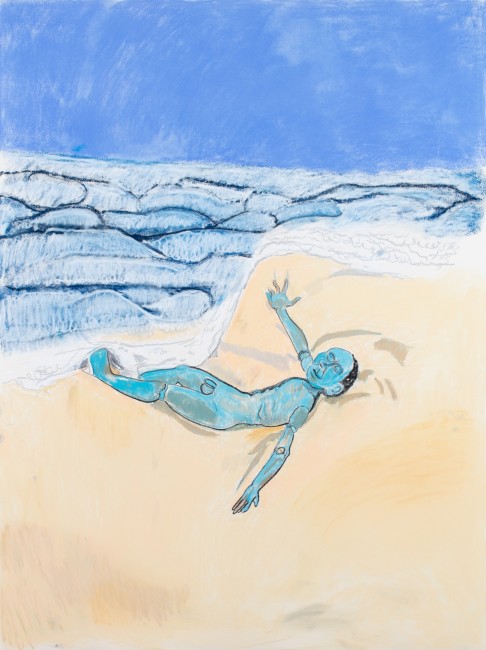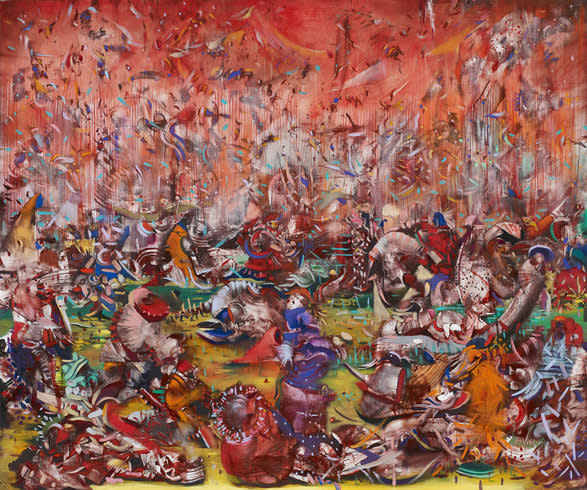A painter of epic vistas and dazzling intricacies, Ali Banisadr creates complex, turbulent worlds whose syncopated rhythms corral a multitude of references from art history as well as allusions to our own turbulent times. In any single, expansive canvas one might sense the crystalline detail of the Persian miniature tradition, the muscular brushwork of Abstract Expressionism, the narrative dexterity of the early Dutch masters, the bravura technique of the Venetian Renaissance, or the libidinous glyphs of Surrealism, among others.
These references reveal themselves not as static, sedimentary layers but as successive waves or currents, series of abstract and semi-abstract forms that flow together, intermingle or collide, submerging and resurfacing, recast and transformed through an often-lengthy process of subtraction and addition. While up-close, elements of the artist’s compositions may recall Bosch-ian hybrid figures, from afar Banisadr’s paintings, with their legions of strafing lines, arcs, blurs and smears of colour evoke, for example, grand world landscapes or the fractured and shimmering surfaces of our digital world.
Their narratives – earthly, celestial, pacific or war-like – unfold in grand, ranging dramas that are informed, though far from defined, by the artist’s own life story. Born in Tehran in 1976, Banisadr left Iran with his family in 1988 at the end of the eight-year Iran-Iraq war, moving briefly to Turkey, then to the US. Living in California for twelve years, first in San Diego then San Francisco, the artist was exposed to graffiti culture at an early age. He participated in the Mission School of graffiti in San Francisco, before attending SVA (School of Visual Arts) for his BFA, later earning an MFA from New York Academy of Art.
Like artists before him, most famously Wassily Kandinsky, Banisadr is a synaesthete who perceives visions in sound. He has spoken of how he first became aware of his synaesthesia, with one sense triggering another, during his childhood in Iran when he would draw ‘to create a visual understanding of the sounds I was hearing – the vibrations, explosions and air raids.’
Sound continues to guide his brushstrokes – their tempo and pressure – as well as the process of bringing together often contradictory elements, which he describes as reaching ‘a certain type of harmony that I find in organising chaotic fragments into a unified symphony.’ While a sense of flux underpins his works, their complex melodies sound notes of optimism. As the artist has said,‘We are in a state of emergency and live in apocalyptic times – man-made and natural disasters, violence and conflict. I think we can heal, but we have to have the vision to see what lies beyond all the confusion and I think artists can play a part in this.’
About the artist
Born in 1976 in Tehran, Iran, Ali Banisadr lives and works in Brooklyn, NY. Recent solo institutional exhibitions include Return to Mother, Princeton University Art Museum, Princeton, USA (2024); Ali Banisadr: Beautiful Lies at Museo Bardini and Palazzo Vecchio, both in Florence, Italy (2021); Ali Banisadr/Matrix 185, Wadsworth Atheneum Museum of Art, Hartford, CT, USA (2020), and Ultramarinus – Beyond the Sea, Benaki Museum, Athens, Greece (2020). His work has been included in recent institutional group exhibitions including Summer Exhibition, Royal Academy of Arts, London (2023); Daphne without Apollo: Metamorphoses from Richter to Lassnig, The Opelvillen Foundation, Rüsselsheim, Germany, (2022); Epic Iran, V&A, London, UK (2021); A Boundless Drop to a Boundless Ocean, Orlando Museum of Art, Florida, USA (2021); Rebel, Jester, Mystic, Poet: Contemporary Persians, Asia Society, New York, NY, USA (2021); Love Me / Love Me Not, Contemporary Art from Azerbaijan and its Neighbours, Venice Biennale, Italy (2013).
Work by the artist is included in major institutional collections including: Albright-Knox Art Gallery, Buffalo, NY, USA; Akademie der Bildenden Künste, Vienna, Austria; British Museum, London, UK; Centre Pompidou, Paris, France; Het Noordbrabants Museum, Den Bosch, Netherlands; Hirshhorn Museum and Sculpture Garden, Washington, DC, USA; K11 Art Foundation, Hong Kong; Los Angeles County Museum of Art, Los Angeles, CA, USA; The Metropolitan Museum of Art, New York, USA; Museum of Contemporary Art, Los Angeles, CA, USA; The Museum of Fine Arts, Houston, USA; Museum der Moderne, Salzburg, Austria; Miniature Museum, The Hague, Netherlands; Philadelphia Museum of Art, Philadelphia, PA, USA; Francois Pinault Foundation, Palazzo Grassi, Venice, Italy; Victoria & Albert Museum, London, UK; Wadsworth Atheneum Museum of Art, Hartford, CT, USA; among others. The first major monograph on the artist was published by Rizzoli in 2021.















































